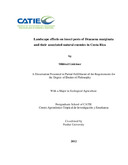| dc.contributor.author | Linkimer Abarca, Mildred | |
| dc.date.accessioned | 2014-10-20T05:17:22Z | |
| dc.date.available | 2014-10-20T05:17:22Z | |
| dc.date.issued | 2012 | es_ES |
| dc.identifier | 376885 | es_ES |
| dc.identifier.uri | https://repositorio.catie.ac.cr/handle/11554/5287 | |
| dc.identifier.uri | http://orton.catie.ac.cr/repdoc/A9029i/A9029i.pdf | es_ES |
| dc.description | Tesis (Ph, D.) -- CATIE. Escuela de Posgrado, Turrialba (Costa Rica), 2012 | es_ES |
| dc.description.abstract | This study examined how the landscape in which D. marginata is embedded affected the abundance and distribution of these three insect pest groups and their associated natural enemies. In order to evaluate the effect of the macro landscape on crop pest abundance, different landscape metrics were evaluated at six spatial scales from local to broad scale. Insect groups showed different responses at different spatial scales. While leafhopper egg abundance was more sensitive in terMON of their correlations with different land uses and metrics katydid egg abundance showed only some isolated correlations at specific spatial scales, metrics and land uses. On the other hand, armored scale abundance practically showed no correlation with any land use and metric at the spatial scales set in this study. Finally, the effect of the landscape at the local scale was evaluated through the response of pest populations and their natural enemies to the presence of weeds from X selective functional groups in the ground cover of D. marginata production fields. Leafhoppers were more sensitive to changes in weed cover composition and females seemed to prefer to concentrate their oviposition on Dracaena plants, which are a suitable host to produce offspring, increasing egg density on grassy treatments. Predatory insects also played an important role regulating leafhopper populations. Vegetation composition and structure strongly influenced katydid distribution as they were never found in areas lacking their preferred hosts. For armored scales other factors, such as dispersal capacity and management practices, are more important for their distribution in the fields. We concluded that the differences in the response among our insect pest groups to the landscape, from broad to local scales, are mainly attributed to a combination of factors that influenced their capacity to disperse, colonize Dracaena fields, and escape from natural enemies. | es_ES |
| dc.language.iso | en | es_ES |
| dc.publisher | CATIE, Turrialba (Costa Rica) | es_ES |
| dc.subject | DRACAENA | |
| dc.subject | INSECTOS DAÑINOS | |
| dc.subject | ENEMIGOS NATURALES | |
| dc.subject | PARASITISMO | |
| dc.subject | TIERRAS AGRICOLAS | |
| dc.subject | PAISAJE ESPACIAMIENTO | |
| dc.subject | COSTA RICA | |
| dc.title | Landscape effects on insect pests of Dracaena marginata and their associated natural enemies in Costa Rica | es_ES |
| dc.type | Tesis de doctorado | es_ES |
| dcterms.rights | acceso abierto | es_Es |
| dc.identifier.publication | Turrialba (Costa Rica) | es_ES |


